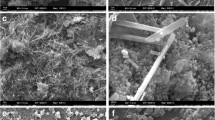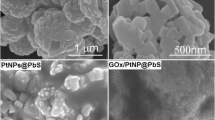Abstract
A biosensor for trace mercury ions based on glucose oxidase (GOD) immobilized on liposome microreactor and chitosan (CS) nanocomposite through layer-by-layer method is described herein. The GOD liposome microreactors (GLMs) were characterized using Fourier transform infrared (FTIR), scanning electron microscopy (SEM), confocal laser scanning microscopy (CLSM), and amperometric methods. The results indicated that GLMs were prepared by encapsulating the enzyme GOD in l-α-phosphatidylcholine liposome resulting in spherical bioreactor with a mean diameter of 5.83 ± 0.75 μm. The encapsulation efficiency and drug loading content of the GLMs were about 53.58 ± 0.91 and 41.15 ± 0.95%, respectively. Cyclic voltammogram (CV) was further utilized to explore relevant electrochemical activity on (CS/GLM)8 nanocomposite-modified glassy carbon electrode (GCE). The biosensor based on the (CS/GLM)8-GCE composite films was applied to detect Hg2+ with a broad linear range from 0.5 to 5.00 μmol/L, and the detection limit was brought down to 0.076 μmol/L. The apparent Michaelis-Menten constant, K m, for the enzymatic reaction was 0.37 mmol/L (S/N = 3). Furthermore, the biosensor showed good stability and reproducibility. Such new biosensor based on encapsulation of GOD within liposome microreactors shows great promise for rapid, simple, and cost-effective analysis of Hg2+ in environmental samples.








Similar content being viewed by others
References
Suchacz B, Wesolowski M (2012) The analysis of heavy metals content in herbal infusions. Cent Eur J Med 7:457–464
Bansal N, Vaughan J, Boullemant A, Leong T (2013) The determination of trace mercury in environmental samples: a review. Chemeca 41:771–776
Xu J, Bravo AG, Lagerkvist A, Bertilsson S, Sjöblom R, Kumpiene J (2015) Sources and remediation techniques for mercury contaminated soil. Environ Int 74:42–53
Guan HN, Liu XF, Wang W, Liang JZ (2014) Direct colorimetric biosensing of mercury(II) ion based on aggregation of poly-(γ-glutamic acid)-functionalized gold nanoparticles. Spectrochim. Acta Part A 121:527–532
Wang L, Gao X, Jin L, Wu Q, Chen Z, Lin X (2013) Amperometric glucose biosensor based on silver nanowires and glucose oxidase. Sens Actuators B: Chem 176:9–14
Guan HN, Zhang FL, Yu J, Chi DF (2012) The novel acetylcholinesterase biosensors based on liposome bioreactors-chitosan nanocomposite film for detection of organophosphates pesticides. Food Res Int 49:15–21
Abu-Shawish HM, Saadeh SM, Hussien AR (2008) Enhanced sensitivity for Cu(II) by a salicylidine-functionalized polysiloxane carbon paste electrode. Talanta 76:941–948
Do JS, Lin KH (2016) Kinetics of urease inhibition-based amperometric biosensors for mercury and lead ions detection. J Taiwan Inst Chem Eng 63:25–32
Malitesta C, Guascito MR (2005) Heavy metal determination by biosensors based on enzyme immobilised by electropolymerisation. Biosens. Bioelectron. 20:1643–1647
Justino CIL, Rocha-Santos TA, Duarte AC (2010) Review of analytical figures of merit of sensors and biosensors in clinical applications. TrAC Trends Anal Chem 29:1172–1183
Zhang Y, Zeng GM, Tang L, Chen J, Zhu Y, He XX, He Y (2015) Electrochemical sensor based on electrodeposited graphene-Au electrode and nano Au carrier amplified signal strategy for attomolar mercury detection. Anal Chem 87:989–996
Zhang Y, Zeng GM, Tang L, Li YP, Chen ZM, Huang GH (2014) Quantitative detection of trace mercury in environmental media using a three-dimensional electrochemical sensor with an anionic intercalator. RSC Adv 4:18485–18492
Anik U, Cubukcu M, Yavuz Y (2013) Nanomaterial-based composite biosensor for glucose detection in alcoholic beverages. Artif Cells Nanomed Biotechnol 41:8–12
Anusha JR, Justin Raj C, Cho BB, Fleming AT, Yu KH, Kim BC (2015) Amperometric glucose biosensor based on glucose oxidase immobilized over chitosan nanoparticles from gladius of Uroteuthis duvauceli. Sens. Actuators B Chem. 215:536–543
Rodriguez BB, Bolbot JA, Tothill IE (2004) Development of urease and glutamic dehydrogenase amperometric assay for heavy metals screening in polluted samples. Biosens. Bioelectron. 19:1157–1167
Moyo M, Okonkwo JO, Agyei NM (2014) An amperometric biosensor based on horseradish peroxidase immobilized onto maize tassel-multi-walled carbon nanotubes modified glassy carbon electrode for determination of heavy metal ions in aqueous solution. Enzym Microb Technol 56:28–34
Cui L, Wu J, Ju H (2015) Electrochemical sensing of heavy metal ions with inorganic, organic and bio-materials. Biosens. Bioelectron. 63:276–286
Soldatkin OO, Kucherenko IS, Pyeshkova VM, Kukla AL, Jaffrezic-Renault N, El’skaya AV (2012) Novel conductometric biosensor based on three-enzyme system for selective determination of heavy metal ions. Bioelectrochem 83:25–30
Rodrigues CG, Wedd AG, Bond AM (1991) Electrochemistry of xanthine oxidase at glassy carbon and mercury electrodes. J Electroanal Chem Interfac 312:131–140
Qiu ZL, Shu J, Jin GX, Wei QH, Chen GN, Tang DP (2016) Invertase-labeling gold-dendrimer for in situ amplified detection mercury(II) with glucometer readout and thymine-Hg2+-thymine coordination chemistry. Biosens Bioelectron 77:681–686
Liu JX, Xu XM, Tang L, Zeng GM (2009) Determination of trace mercury in compost extract by inhibition based glucose oxidase biosensor. Trans Nonferrous Met Soc China 19:235–240
Ayenimo JG, Adeloju SB (2015) Inhibitive potentiometric detection of trace metals with ultrathin polypyrrole glucose oxidase biosensor. Talanta 137:62–70
Ghica ME, Carvalho RC, Amine A, Brett CMA (2013) Glucose oxidase enzyme inhibition sensors for heavy metals at carbon film electrodes modified with cobalt or copper hexacyanoferrate. Sens. Actuators B Chem. 178:270–278
Decher G, Hong JD, Schmitt J (1992) Buildup of ultrathin multilayer films by a self-assembly process: III. Consecutively alternating adsorption of anionic and cationic polyelectrolytes on charged surfaces. Thin Solid Films 210-211:831–835
Wang LE, Liu CG, Yang WS (2016) Non-enzymatic acetylcholine electrochemical biosensor based on flower-like NiAl layered double hydroxides decorated with carbon dots. Sens Actuators B Chem 233:199–205
Chen Q, Han J, Shi H, Wu B, Xu XH, Osa T (2004) Use of chitosan for developing layer-by-layer multilayer thin films containing glucose oxidase for biosensor applications. Sensor Lett 1:102–105
Nazemi Z, Shams E, Amini MK (2016) Construction of a biointerface for glucose oxidase through diazonium chemistry and electrostatic self-assembly technique. J Solid State Chem 20:429–438
Zhang Y, Zeng GM, Tang L, Li YP, Chen LJ, Pang Y, Li Z, Feng CL, Huang GH (2011) An electrochemical DNA sensor based on a layers-film construction modified electrode. Analyst 136:4204–4210
Guo W, Johnson JL, Khan S, Ahmad A, Ahmad I (2005) Paclitaxel quantification in mouse plasma and tissues containing liposome-entrapped paclitaxel by liquid chromatography-tandem mass spectrometry: application to a pharmacokinetics study. Anal Biochem 336:213–220
Smith AM, Jaime-Fonseca MR, Grover LM, Bakalis S (2010) Alginate-loaded liposomes can protect encapsulated alkaline phosphatase functionality when exposed to gastric pH. J Agric Food Chem 58:4719–4724
Vamvakaki V, Chaniotakis NA (2007) Pesticide detection with a liposome-based nano-biosensor. Biosens Bioelectron 22:2848–2853
Danilich MJ, Gervasio D, Marchant RE (1993) Activity of free and immobilized glucose oxidase: an electrochemical study. Ann Biomed Eng 21:655–668
Zhang Y, Zeng GM, Tang L, Niu CG, Pang Y, Chen LJ, Feng CL, Huang GH (2010) Highly sensitive fluorescence quantification of picloram using immunorecognition liposome. Talanta 83:210–215
Stoytcheva M, Zlatev R, Velkova Z, Valdez B, Ovalle M, Petkov L (2009) Hybrid electrochemical biosensor for organophosphorus pesticides quantification. Electrochim Acta 54:1721–1727
Liu T, Su HC, Qu XJ, Ju P, Cui L, Ai SY (2011) Acetylcholinesterase biosensor based on 3-carboxyphenylboronic acid/reduced graphene oxide-gold nanocomposites modified electrode for amperometric detection of organophosphorus and carbamate pesticides. Sens. Actuators B Chem. 160:1255–1261
Wu BY, Hou SH, Yu M, Qin X, Li S, Chen Q (2009) Layer-by-layer assemblies of chitosan/multi-wall carbon nanotubes and glucose oxidase for amperometric glucose biosensor applications. Mater Sci Eng C 29:346–349
Tuoro DD, Portaccio M, Lepore M, Arduini F, Moscone D, Bencivenga U, Mita DG (2011) An acetylcholinesterase biosensor for determination of low concentrations of Paraoxon and Dichlorvos. New Biotech 29:132–138
Scott DL, Bowden EF (1994) Enzyme-substrate kinetics of adsorbed cytochrome c peroxidase on pyrolytic graphite electrodes. Anal Chem 66:1217–1223
Tang L, Zeng GM, Shen GL, Li YP, Zhang Y (2008) Rapid detection of picloram in agricultural field samples using a disposable immunomembrane-based sensor. Environ Sci Technol 42:1207–1212
Soldatkin OO, Kucherenko IS, Pyeshkova VM, Kukla AL, Jaffrezic-Renault N, El’skaya AV, Dzyadevych SV, Soldatkin AP (2012) Novel conductometric biosensor based on three-enzyme system for selective determination of heavy metal ions. Bio Elec Chem 83:25–30
Guascito MR, Malitesta C, Mazzotta E, Turco A (2008) Inhibitive determination of metal ions by an amperometric glucose oxidase biosensor study of the effect of hydrogen peroxide decomposition. Sens. Actuators B Chem. 131:394–402
Ho JA, Hsu HW, Huang MR (2004) Liposome-based microcapillary immunosensor for detection of Escherichia coli O157:H7. Anal Biochem 330:342–349
Acknowledgements
This work was supported by the National Natural Science Foundation of China (Nos. 31370649 and 31201376), the Planning Subject of “The Twelfth Five-Year-Plan” in the National Science and Technology for the Rural Development in China (2012BAD19B0704), the China Postdoctoral Science Foundation (2014T70304, 2013M531009), University Nursing Program for Young Scholars with Ceative Talents in Heilongjiang Province (2016060) and the Heilongjiang Postdoctoral Fund (LBH-Z13002). The authors gratefully acknowledge the financial support by Material Science and Engineering College of Northeast Forestry University in China.
Author information
Authors and Affiliations
Corresponding author
Rights and permissions
About this article
Cite this article
Yu, J., Guan, H. & Chi, D. An amperometric glucose oxidase biosensor based on liposome microreactor-chitosan nanocomposite-modified electrode for determination of trace mercury. J Solid State Electrochem 21, 1175–1183 (2017). https://doi.org/10.1007/s10008-016-3468-0
Received:
Revised:
Accepted:
Published:
Issue Date:
DOI: https://doi.org/10.1007/s10008-016-3468-0




